Integrated report 2019
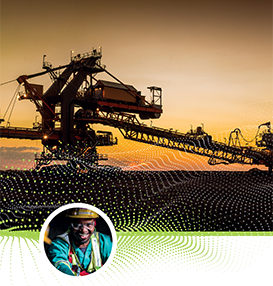
The Coal Resource and Coal Reserve strategy is focused on sustaining, developing and growing the mineral asset base through the employment of responsible and innovative technical management. The value extracted from the mineral assets is continuously challenged through mine planning, considering the evolving knowledge of the mineral asset geological complexities and the opportunities. Our competent persons are the custodians of the mineral asset and are therefore accountable not only to ensure the integrity but also to apply pioneering technology in combination with trusted knowledge to optimise the exploitation thereof.
Our projects, operations and expansion initiatives are built on trusted and assured Coal Resources and Coal Reserves, creating the platform for the life of mine (LoM) from which the annual business plans are derived. The Mineral Resource managers of each operation are the custodians of the LoM and ensure the professional execution of the business plans, stimulating profitability and return on investment while guarding against irresponsible exploitation.
Exxaro has a world-class coal resource portfolio, comprising fully owned operations and projects, and a number of jointly owned operations and projects, in South Africa and Australia. The fully owned operations and projects in South Africa are located in the large and highly prospective Waterberg Coalfield in Limpopo, and the more mature Highveld and Witbank Coalfields in Mpumalanga. Since inception in 2006, Exxaro's total attributable Coal Resource and Coal Reserve figures have been relatively stable. This trend can primarily be ascribed to the relatively large Waterberg coal deposits, particularly the remarkable Grootegeluk complex. Estimated to contain 40% to 50% of South Africa's remaining Coal Resources, the Waterberg is viewed as the future of South African coal mining. Exxaro holds an estimated three billion tonnes of Measured and around 1.8 billion tonnes of Indicated Coal Resources in the Waterberg, primarily at Grootegeluk mine and the adjacent Thabametsi mining right. The Grootegeluk complex provides thermal Coal Reserves to Eskom's Matimba and new Medupi power stations, and produces semi-soft coking and metallurgical coal through eight beneficiation plants.
The Grootegeluk complex is continuously evolving, illustrated by several large value-unlocking projects. While these projects underline the resourcefulness of our people, they also demonstrate the successful implementation of innovative breakthrough technology. To an extent, the size of the Grootegeluk complex obscures changes in Coal Resource and Coal Reserve figures from events in the smaller Witbank and Highveld coalfields. In 2014, divestment from the new Clydesdale Colliery, closure of Inyanda mine and incorporation of Total Coal South Africa (renamed Exxaro Coal Central or ecc), as well as divestment from the Eloff project in 2017, affected Exxaro's reported figures in recent years.
Figure 1: Locations of our coal operations and projects

 The significant change in Coal Resources from 2018
to 2019 is the result of the decision to relinquish the
Waterberg North and South prospecting rights.
The significant change in Coal Resources from 2018
to 2019 is the result of the decision to relinquish the
Waterberg North and South prospecting rights.
Figure 2: Exxaro estimates over time
Exxaro’s attributable Coal Resources and Coal Reserves
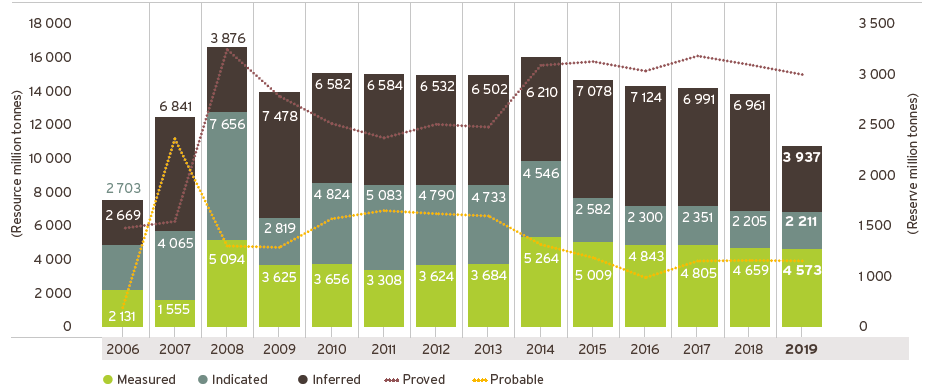
Mpumalanga attributable: Witbank coalfields (excluding Matla and Arnot)
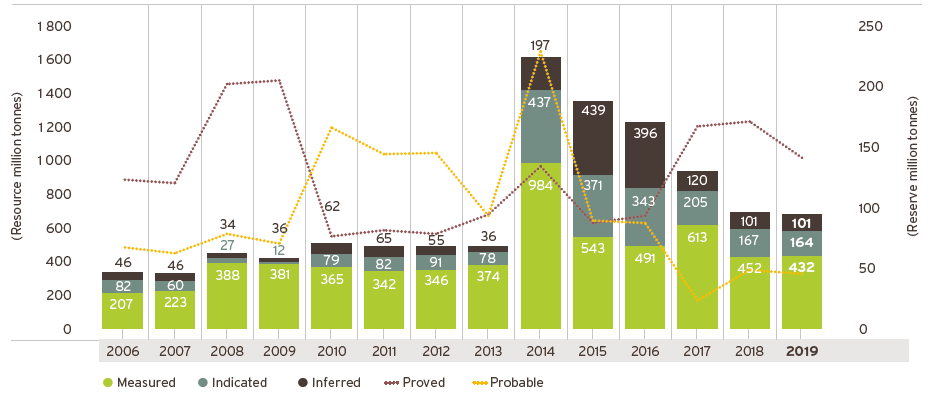
Notes
During 2018, Exxaro cautioned the market that the group was considering options relating to four prospecting rights grouped into two projects, namely Waterberg North and South. The projects are located approximately 30km north of Grootegeluk, and consist of 2 147Mt and 869Mt of Inferred Coal Resources respectively.
This year, following in-depth discussions concerning the strategic alignment of these prospecting rights, a decision was taken to relinquish them, resulting in the Exxaro total attributable Coal Resource decreasing by approximately 22%. The prospecting rights are in closure and we are responsibly conducting all activities to ensure we fulfil the necessary closure requirements.
Furthermore, during the course of the year, total Exxaro attributable Coal Reserves decreased by approximately 3%. The Coal Reserve for the Forzando operation, which forms part of the ECC Complex, decreased by approximately 37% for the reporting year. The most significant contributors to the decrease are mining, review of macro-economic assumptions and areas excluded due to unfavourable floor gradients.
Changes in Coal Reserves larger than 10% (material) are also reported at the Matla and Leeuwpan operations. The approximate 13% decrease at Leeuwpan is primarily the result of mining whereas the 14% decrease at Matla is due to mining and the disposal of mining areas related to unfavourable stooping conditions in close proximity to surface infrastructure. For all other operations, other than normal LoM depletion, no material changes to Mineral Resource and Mineral Reserve estimates are reported.
In 2019, we continued to focus on unlocking value at our operations. We are acutely aware that our success as a mining company is built on the integrity of our Coal Resources and the effectiveness with which we convert these resources to Coal Reserves, and then the exploitation and extraction of these Reserves.

Considering mining, metallurgical, processing, infrastructural, economic, marketing, legal, environmental, social and governmental modifying factors
Continuously improving our level of geoscientific understanding, minimising risk and unlocking opportunities
Executing integrated exploration
plans at the Dorstfontein,
Forzando, Matla, Belfast,
Grootegeluk and Leeuwpan mines
Update of geological and
structural models at the Matla,
Grootegeluk and Leeuwpan mines
Consideration of geological risk in
conditional-based mine planning
at Matla and ECC
Modifying factors and our ability to extract our Mineral Resources. Increasing extraction through innovation and knowledge
Application of a geometallurgical approach to multi-bench mining at Grootegeluk
Implementation of the autonomous drilling strategy at Grootegeluk
Optimising our plans to create the best fit-for-market use. Optimised LoM plans
Update of LoM for Matla, Belfast and Leeuwpan mines
Initiation of Matla north-west access incline and decline projects
Optimising centrally managed geological and hydrogeological databases
Pit scanning for the use of geotechnical and structural interpretations
Surveying holes using optical televiewer (OTV), acoustic televiewer (ATV) and sonic to obtain geotechnical information on the rock mass
Continuous radar scanning for slope stability monitoring
Terrestrial lidar scanning of pit faces to enhance reconciliation and Resource use
Implementation of the opencast coal solution (OCCS) and the underground coal solution (UGCS) for the development of mine layouts and mine schedules
From 2017, we aligned our reporting with SAMREC 2016 and JSE 2016 amendments for minimum contents of annual reports and have subsequently updated our LoM mineral assets policies and estimation procedures. We have updated our internal competent persons reports (CPRs) for 2017, 2018 and 2019 to accommodate the SAMREC 2016 “if not, why not” principle. We have also reviewed and updated our functional procedures and created an overarching exploration standard for all operations and projects under Exxaro management.
We have conducted tier 1 Resource reviews at Grootegeluk (in process), Matla and Leeuwpan as well as reviews on LoM plans of Matla, Belfast and Leeuwpan. Tier 2 technical reviews were conducted on Matla Mine 1 Relocation, Matla Mine 2 Incline, Matla Mine 3 Decline and the Dorstfontein East underground projects. We have conducted tier 3 (third-party) reviews at corporate centre and Matla mine. The outstanding external 2018 findings were resolved, and corporate centre and Matla received no findings in 2019. The CMRR report was peer reviewed for reporting compliance.
The Dorstfontein West underground future operational life beyond the exhaustion of number 2 coal seam (S2) is premised on the exploitation of number 4 (lower) (S4L) coal seam. The S4L has an average seam height of 3m, which allows for higher run-of-mine (RoM) production rate per section compared with mining from the lower seam heights of the S2 albeit with somewhat lower coal qualities. A project was initiated in 2019 whereby the S4 was successfully accessed from existing S2 underground infrastructure. Two parallel 7m-wide and 2m-high inclines with a slope of six degrees, connected by six crosscuts, were developed by the Dorstfontein drill-and-blast stone development team. A 500 tonne bunker was developed between S4 and S2 to provide RoM coal surge capacity for the higher RoM coal production rate and to feed onto the existing conveyor systems from S2 infrastructure to surface. A concurrent expansion of the coal washing plant was implemented to accommodate the consequential higher RoM coal production rates levels of ~1.8Mtpa from the three continuous miner sections. This entails retaining a bypass of ~15% of the fine RoM coal directly to product but segmenting the coarser coal flow by size fraction between a new small coal plant and the existing drum and cyclone plants. The new small coal plant consists of cyclone and spiral modules. The higher production rates required upgrading of the load-out area including a stacker, roads and weighbridge as well as an extension of the discard storage facilities. We thus unlocked a significant S4 Coal Resource and associated Coal Reserve. The project was successfully implemented and the operation is currently extracting coal from the newly developed mine infrastructure.

ECC operations are characterised by areas that have been greatly affected by dolerite activity, which present in the form of dykes and sills. In addition, floor undulations and steep gradients present challenges, especially in the underground operations. These features tend to be more prevalent along paleo highs and near dolerite structures, and pose a risk to safety and effective coal extraction. ECC employs an exploration strategy to proactively and accurately predict the extent of these challenging geological features. The exploration strategy adopts an integrated approach with the investigation, identification and delineation of possible challenging features associated with the future exploitation of Coal Reserves.
Identified features applicable to Resource accessibility, mine-ability (roof/floor conditions) and Coal Resource characterisation (coal seam thickness and quality variability) are captured in our risk and opportunity domain analysis (RODA). Areas are identified and assigned higher geological loss through the application of querying and modelling techniques within the GIS-based RODA. The RODA is then considered during mine planning, influencing the orientation of mining layouts, mining tempos, production volumes, cutting rates, and associated mining and rehabilitation costs aligned with the identified risks or restricted zones. Areas perceived as low risk, if not already defined as Reserves, are highlighted and investigated as opportunities for inclusion in the future.
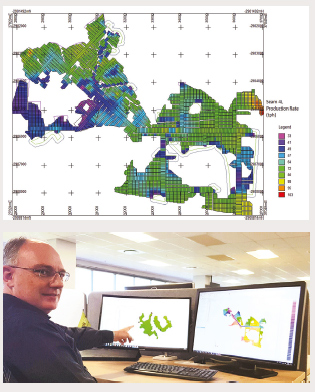
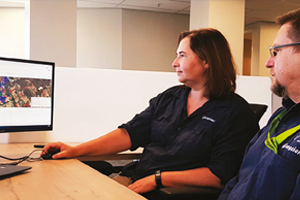
For the development of LoM plans, the mining department is transitioning from Runge’s Xpac to the new Runge software solutions, namely OCCS and UGCS for the development of mine layouts and mine schedules. These tools shorten the development time and reduce the need to convert information from one software package to another, thus enabling the department to develop more scenarios than in the past, improving the selection process when finalising the LoM plans. The OCCS software has been implemented at Belfast coal mine and test work is being done with the UGCS to determine if this product can address the needs of the organisation. The test work has shown positive results and further development is currently being rolled out.
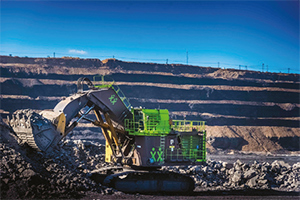
Exxaro has embarked on establishing a centralised geological system (acQuire) to ensure the integrity and security of our geoscientific data. The solution offers improved integration between the various geoscientific disciplines (geology, geotechnical and geophysical information) and the potential to have almost real-time information. Similarly EQuIS software has successfully been implemented for the monitoring and management of geohydrological information, and it will be fully autonomous. Both systems are cloud-based with web integration and the capability for direct field capturing. The majority of the validations are at the point of capture to ensure compliance with established business rules. The principle is that the databases form a single source for all business decisions relating to geoscientific information going forward.